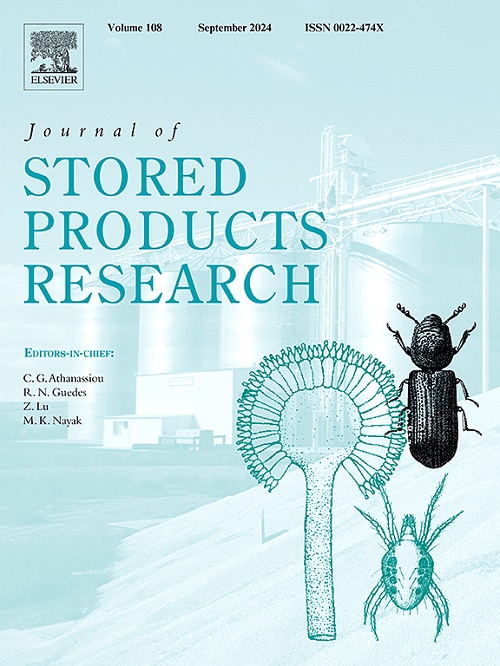优化磷化氢在印度仓库袋装大米防虫中的应用
IF 2.7
2区 农林科学
Q1 ENTOMOLOGY
引用次数: 0
摘要
在全球逐步淘汰甲基溴的过程中,膦被认为是一种可行的替代品,但由于有关其实地应用的报告有限,需要对印度的熏蒸效果进行评估。这项研究通过将150吨大米堆叠成30堆(每堆5吨)来评估磷化氢对储存谷物昆虫的有效性,该研究重复了三次,包括相同数量的对照。目标昆虫包括三个地点的castaneum Tribolium (Herbst, 1797)(鞘翅目:拟步甲科)、Sitophilus oryzae (Lin, 1763)(鞘翅目:Curculionidae)和Rhyzopertha dominica (Fab, 1792)(鞘翅目:bostricidae)。两种磷化铝(AlP)制剂(56%,2片和3片/吨);77.5%颗粒1.0和1.5 g磷化氢/m³)在所有地点暴露7天和10天进行测试。对处理后60 d的昆虫进行监测,除卡塔克的castaneum野外种群外,其余昆虫死亡率均为100%。在28-36℃、52-80%的湿度条件下,在1.5 g/m³的磷化氢气体中暴露7天后,500-700 ppm的磷化氢可以有效地控制未处理的侵染谷物的所有阶段。累积Ct值为264 ~ 332 g h/m³,各位置的气体耗散为15 ~ 16%。磷化氢对水稻贮藏害虫防治效果显著。本文章由计算机程序翻译,如有差异,请以英文原文为准。
Optimizing phosphine applications for insect control in Bagged rice stored in Indian warehouses
Phosphine, considered a viable substitute for methyl bromide amid its global phase-out, requires assessment for fumigation efficacy in India due to limited reports on its field applications. This study assessed phosphine's effectiveness against stored grain insects by stacking 150 tonnes of rice into 30 stacks (5 tonnes each), replicated thrice with including same number of controls. Target insects included Tribolium castaneum (Herbst, 1797) (Coleoptera: Tenebrionidae), Sitophilus oryzae (Lin, 1763) (Coleoptera: Curculionidae), and Rhyzopertha dominica (Fab, 1792) (Coleoptera: Bostrichidae) across three locations. Two aluminium phosphide (AlP) formulations (56% at 2 and 3 tablets/tonne; 77.5% granule at 1.0 and 1.5 g phosphine/m³) were tested with 7- and 10-day exposures at all locations. Insects were monitored for 60 days post-treatment, achieving 100% mortality except for the field population of T. castaneum at Cuttack. Phosphine at 500–700 ppm could effectively control all insect stages in untreated infested grains at 1.5 g/m³ phosphine gas following 7 days exposure at 28–36 °C and 52–80% humidity. Cumulative Ct values ranged from 264 to 332 g h/m³, with 15–16% gas dissipation across locations. Phosphine proved effective for rice storage pest control.
求助全文
通过发布文献求助,成功后即可免费获取论文全文。
去求助
来源期刊
CiteScore
5.70
自引率
18.50%
发文量
112
审稿时长
45 days
期刊介绍:
The Journal of Stored Products Research provides an international medium for the publication of both reviews and original results from laboratory and field studies on the preservation and safety of stored products, notably food stocks, covering storage-related problems from the producer through the supply chain to the consumer. Stored products are characterised by having relatively low moisture content and include raw and semi-processed foods, animal feedstuffs, and a range of other durable items, including materials such as clothing or museum artefacts.

 求助内容:
求助内容: 应助结果提醒方式:
应助结果提醒方式:


